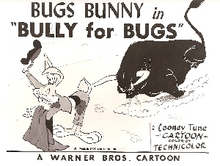| Bully for Bugs | |
|---|---|
 Lobby card | |
| Directed by | Charles M. Jones |
| Story by | Michael Maltese |
| Produced by | Edward Selzer (uncredited) |
| Starring | Mel Blanc |
| Music by | Carl Stalling |
| Animation by | Ben Washam Lloyd Vaughan Ken Harris Harry Love (effects animation) |
| Layouts by | Maurice Noble |
| Backgrounds by | Philip De Guard |
| Color process | Technicolor |
Production company | |
| Distributed by | Warner Bros. Pictures The Vitaphone Corporation |
Release date |
|
Running time | 7:11 |
Bully for Bugs is a 1953 Warner Bros. Looney Tunes theatrical cartoon short directed by Chuck Jones and written by Michael Maltese.[1] The cartoon was released on August 8, 1953, and stars Bugs Bunny.[2]
YouTube Encyclopedic
-
1/2Views:2 0757 492
-
Attack of the Bully Bug
-
BYE BYE BIG BAD BULLY BUG BY ED EMBERLEY
Transcription
Plot
Bugs Bunny finds himself inadvertently embroiled in a bullfighting spectacle while en route to the Coachella Valley for a carrot festival. Upon stumbling into a Spanish bullring, Bugs becomes the target of Toro the Bull, who is engaged in a confrontation with a matador. Despite attempting to seek assistance from the matador for directions, Bugs is met with disregard, prompting him to confront Toro himself.
Determined to retaliate against Toro's aggression, Bugs dons matador attire and employs clever tactics to outwit the bull. Utilizing an anvil concealed within his cape, Bugs manages to subdue Toro momentarily, only to face a resilient adversary capable of detaching his horns for a counterattack. The ensuing battle between Bugs and Toro unfolds with comedic flair, marked by inventive strategies and physical slapstick humor.
Amidst the escalating conflict, Bugs employs inventive traps and comedic banter to outsmart Toro, culminating in an explosive finale orchestrated through a series of humorous mishaps and Rube Goldberg-esque contraptions. Ultimately, Bugs emerges victorious, utilizing quick thinking and resourcefulness to outmaneuver Toro and secure his escape.
Development
In his biography Chuck Amuck, Chuck Jones claims that he made this cartoon after producer Eddie Selzer burst into Jones' workspace one day and announced, for no readily apparent reason, that there was nothing funny about bullfighting and no cartoons about it were to be made.[3] Since Selzer had, in Jones' opinion, consistently proven himself to be wrong about absolutely everything (having once barred Jones from doing any cartoons featuring Pepé Le Pew, on the grounds that he perceived them as not being funny, which led to Jones and Maltese to do For Scent-imental Reasons, which won an Oscar, which Selzer accepted), the only possible option was to make the cartoon. The sounds of the crowd and the bull are recorded from a genuine bullfighting crowd in Barcelona, Spain. The boulder to the face gag was reused from Rabbit Punch five years earlier, which was also directed by Chuck Jones.
Reception
Darrell Van Citters writes, "This film hits squarely in director Chuck Jones' sweet spot and features most of the creative team we've come to associate with his best work... Both the writing and directing are self-assured, and there is no wasted effort anywhere in the film. Jones was a master of timing and the expressive hold. Often his holds would be followed up by the movement of one body part, such as an eyebrow raise, making the statement even more effective. In his best films, such as Bully for Bugs, his timing revealed character, making the moment all the funnier."[4]
Home media
- VHS: Bugs Bunny's Wacky Adventures
- VHS: From Hare to Eternity
- Laserdisc: Bugs Bunny: Winner by a Hare
- DVD: Looney Tunes Golden Collection: Volume 1
- DVD/Blu-ray: Looney Tunes Platinum Collection: Volume 3
- DVD: Looney Tunes: Bugs Bunny And Friends (Full Frame)
References
- ^ Beck, Jerry; Friedwald, Will (1989). Looney Tunes and Merrie Melodies: A Complete Illustrated Guide to the Warner Bros. Cartoons. Henry Holt and Co. p. 251. ISBN 0-8050-0894-2.
- ^ Lenburg, Jeff (1999). The Encyclopedia of Animated Cartoons. Checkmark Books. pp. 60–62. ISBN 0-8160-3831-7. Retrieved 6 June 2020.
- ^ Furniss, Maureen (2005). Chuck Jones: Conversations. Univ. Press of Mississippi. p. 198. ISBN 978-1-57806-729-9.
- ^ Beck, Jerry, ed. (2020). The 100 Greatest Looney Tunes Cartoons. Insight Editions. pp. 30–31. ISBN 978-1-64722-137-9.
